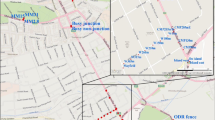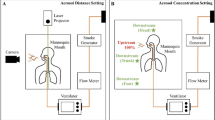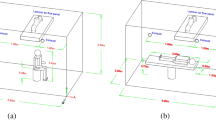Summary
Under extreme conditions, ambulance attendants and drivers could be exposed to nitrous oxide administered to transported patients in concentrations causing acute effects. Special arrangements are necessary to prevent such exposure, which is influenced by travelling speed, local exhaust ventilation and the use of an excess gas transfer tube evacuating expired air and overflow gas from the face mask to the outside. The separate eliminative effects of travelling speed and local exhaust varied considerably with the experimental conditions. The excess gas transfer tube reduced the levels of nitrous oxide in the air by 86 to 97% inside the ambulance at different experimental conditions. The combination of excess gas transfer tube and local exhaust resulted in a relatively constant reduction of the airborne nitrous oxide levels by about 98% when the ambulance was at a standstill and 99% when it was running.
Similar content being viewed by others
References
Ancker K, Halldin M, Göthe CJ (1980) Nitrous-oxide analgesia during ambulance transportation. Airborne levels of nitrous oxide. Acta Anaesth Scand 24:497–500
Baskett PJF, Withnell A (1970) Use of Entonox in the ambulance service. Br Med J 2:41–43
Blomberg R, Furhoff AK, Halldin M, Svedberg S (1978) Smärtlindring på olycksplats och under transport. (Pain relief at the scene of accidents and during transportation) (in Swedish). Lakartidningen 75:4368
Blomberg R, Karlowski HP, Olofsson L, Svedberg S (1980) Kontamination av arbetsmiljön med lustgas vid användning av Entonox inom ambulansvården. (Contamination of the work environment with nitrous oxide when using Entonox in the ambulance service) (in swedish). Opuscula Medica [Stockh] 25:151–152
Bristow A, Giesecke AH, Thal E, Atkins JM (1986) Environmental concentrations of nitrous oxide in a modular ambulance. Cr Care Med 14:815–816
Donen N, Tweed WA, White D, Guttormson B, Enns J (1982) Pre-hospital analgesia with Entonox. Can Anaesth Soc J 29:275–279
Larean A, Laprevote-Heully MC, Voltz C (1978) Analagésie obtenue lors du transport des blessés et mélades à l'aide d'un mélange équimoléculaire protoxyde d'azote-oxygène. Nouv Presse Med 7:1855
McKinnon KD (1981) Pre-hospital analgesia with nitrous oxide/oxygen. Can Med Assoc J 125:836–840
Olander L (1974) Operationsrums ventilationsstandard. Lustgaskoncentrationer i operationsrum. (Ventilation standard of operation theatres. Nitrous oxide concentrations in operation theatres) (in Swedish). Arbete och Hälsa [Stockh] 3:41 pp
Thal ER, Montgomery SJ, Atkins JM, Roberts BG (1979) Self-administered analgesia with nitrous oxide. Adjunctive aid for emergency medical care systems. JAMA 242:2418–2419
Wright CJ, McDowall DG, Wilson J, Hain WR, Furness R, Daykin JH (1972) Pre-mixed nitrous oxide-oxygen analgesia in the ambulance service. Anaesthesia 27:459–460
Author information
Authors and Affiliations
Rights and permissions
About this article
Cite this article
Ancker, K., Göthe, CJ. & Halldin, M. Local exhaust ventilation and exposure to nitrous oxide in ambulances. Int Arch Occup Environ Health 62, 27–29 (1990). https://doi.org/10.1007/BF00397845
Received:
Accepted:
Issue Date:
DOI: https://doi.org/10.1007/BF00397845




